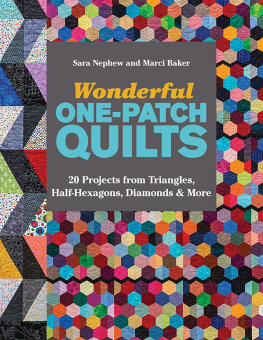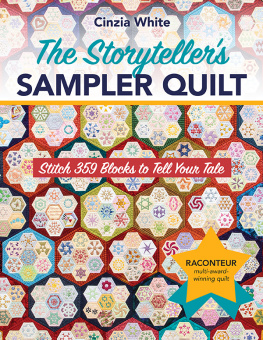Publisher: Amy Marson Creative Director: Gailen Runge Editor: Lynn Koolish Technical Editors: Debbie Rodgers and Gailen Runge Cover/Book Designer: April Mostek Production Coordinators: Zinnia Heinzmann and Joe Edge Production Editor: Alice Mace Nakanishi Illustrator: Freesia Pearson Blizard Photo Assistants: Carly Jean Marin and Mai Yong Vang Photography by Diane Pedersen of C&T Publishing, unless otherwise noted Published by C&T Publishing, Inc., P.O. Box 1456, Lafayette, CA 94549 dedication To my parents, Lloyd and Kathy Towers, for teaching me how to reach for the stars, and to my husband, Derrick, for believing I could quilt them.  acknowledgments This book would not have been possible without the support of so many lovely people. Thank you to Amy Jameson, for the amazing longarm quilting. You rock. Thank you to Elizabeth Simmons, Hillary Shenkle, Trey Towers, Greg and Debbie Breclaw, Cathy Slovensky, and Teresa Duryea Wong for support and encouragement throughout this journey.
acknowledgments This book would not have been possible without the support of so many lovely people. Thank you to Amy Jameson, for the amazing longarm quilting. You rock. Thank you to Elizabeth Simmons, Hillary Shenkle, Trey Towers, Greg and Debbie Breclaw, Cathy Slovensky, and Teresa Duryea Wong for support and encouragement throughout this journey.
Thank you to Candice Hoffman, Daryl Cohen, Demetria Hayward, and Stephanie Menjivar for providing gorgeous fabric. Thank you to all the online friends and followers of The Caffeinated Quilteryour kind words and interest in my work mean the world to me. And thank you especially to my five wonderful children. Thanks for putting up with my craziness, making me smile even on deadline days, and reminding me of whats most important. 
 Hexagons make stupendous quilts. Their unusual shape, ability to tile, and radial patterns are inspiring.
Hexagons make stupendous quilts. Their unusual shape, ability to tile, and radial patterns are inspiring.
Intricate hexagon quilts merit a second glance at a quilt show, and they beg the question, How did the quilter do that? Adventures in Hexagons answers that question. In the following chapters, youll find several detailed methods for cutting and piecing hexagons. Whatever method you choose, youll soon discover that hexagons arent really any more difficult to sew than squaresand theyre considerably more interesting! Traditionally hexagon quilts have been considered a one-patch layout, meaning hexagons of the same shape and size are used across the entire quilt (think Grandmothers Flower Garden and Tumbling Blocks). With Adventures in Hexagons, you can stretch the boundaries of that one-patch grid and use it as a springboard for creating designs with multiple sizes of hexagons in one quilt. Heres how it works: Think of a block in terms of how many hexagons are used to create it.  A triple block is made up of three hexagons, giving you the freedom to incorporate a more complex design than you can with just singles.
A triple block is made up of three hexagons, giving you the freedom to incorporate a more complex design than you can with just singles.  A rosette block is made up of seven hexagons (six surrounding a single center hexagon).
A rosette block is made up of seven hexagons (six surrounding a single center hexagon).  A rosette block is made up of seven hexagons (six surrounding a single center hexagon).
A rosette block is made up of seven hexagons (six surrounding a single center hexagon).
This is the same hexagon arrangement as you would find in a Grandmothers Flower Garden quilt, but by playing with how you fit shapes within that seven-block arrangement, you can create a large variety of designs.  The final two block types youll explore in this book are sprockets and medallions. Sprockets are made up of thirteen hexagons. Think of them as rosettes with extra hexagons around the edges. The uneven edge of this shape gives your quilts a dynamic impact.
The final two block types youll explore in this book are sprockets and medallions. Sprockets are made up of thirteen hexagons. Think of them as rosettes with extra hexagons around the edges. The uneven edge of this shape gives your quilts a dynamic impact. 
 Medallions are the showstoppers.
Medallions are the showstoppers.
With nineteen hexagons combined into this super-rosette shape, you have a lot of room to incorporate all kinds of 60 shapes into visually stunning designs. 
 They still fit within the one-patch layout but allow for designs much larger than the original hexagon. Combine all of these together and you have a hexagon sampler quilt that is truly stellar.
They still fit within the one-patch layout but allow for designs much larger than the original hexagon. Combine all of these together and you have a hexagon sampler quilt that is truly stellar.  Mini-quilts made by Emily Breclaw featuring Chalk and Paint fabrics, by Sew Caroline for Art Gallery Fabrics Adventures in Hexagons presents a framework illustrating the use of the hexagon grid as a tool for creating unusual layouts and radical (radial) designs that defy tradition. how to use this book Adventures in Hexagons is divided into several sections. The beginning chapters will show you step by step how to prepare and sew hexagons, using either templates or English paper piecing (EPP).
Mini-quilts made by Emily Breclaw featuring Chalk and Paint fabrics, by Sew Caroline for Art Gallery Fabrics Adventures in Hexagons presents a framework illustrating the use of the hexagon grid as a tool for creating unusual layouts and radical (radial) designs that defy tradition. how to use this book Adventures in Hexagons is divided into several sections. The beginning chapters will show you step by step how to prepare and sew hexagons, using either templates or English paper piecing (EPP).
Sewing with acrylic templates is my absolute favorite method for sewing hexagons, mostly because I love having the ability to sew either by hand or machine within the same project. If you dont have (and dont want to buy) acrylic templates, make your own templates using the patterns at the back of the book. English paper piecing is a close second because its a wonderfully portable method of quiltingyou dont have to worry about perfectly precise cutting, and its a fantastic way to make even the most complex quilt blocks achievable for a motivated sewist. And, of course, the fact that beautiful piles of basted hexies make lovely Instagram and Pinterest pictures doesnt hurt, either! Please note that all the sample quilts were sewn with templates, yet all the illustrations were drafted without seam allowances to make them easy to follow regardless of your piecing preferences. It was my intention to enable quilters using EPP to make the projects in this book with the diagrams alone, so I hope you find them easy to follow. If you already have a favorite sewing method for sewing hexagons, jump straight into the projects, where youll find quilts in a range of sizes and skill levels.
The final section, the Design Primer, is intended to help you design your own hexagon quilts. Discover alternative possibilities by swapping out blocks in the books quilt layouts, or create designs that are entirely your own! I hope this book inspires you to create pieced hexagon quilts. Even more, I hope it inspires you to dream in hexagonsand provides you with the tools you need to turn those dreams into reality. I cant wait to journey with you through this universe of hexagon quilt possibilities! 
Next page












 acknowledgments This book would not have been possible without the support of so many lovely people. Thank you to Amy Jameson, for the amazing longarm quilting. You rock. Thank you to Elizabeth Simmons, Hillary Shenkle, Trey Towers, Greg and Debbie Breclaw, Cathy Slovensky, and Teresa Duryea Wong for support and encouragement throughout this journey.
acknowledgments This book would not have been possible without the support of so many lovely people. Thank you to Amy Jameson, for the amazing longarm quilting. You rock. Thank you to Elizabeth Simmons, Hillary Shenkle, Trey Towers, Greg and Debbie Breclaw, Cathy Slovensky, and Teresa Duryea Wong for support and encouragement throughout this journey.
 Hexagons make stupendous quilts. Their unusual shape, ability to tile, and radial patterns are inspiring.
Hexagons make stupendous quilts. Their unusual shape, ability to tile, and radial patterns are inspiring. A triple block is made up of three hexagons, giving you the freedom to incorporate a more complex design than you can with just singles.
A triple block is made up of three hexagons, giving you the freedom to incorporate a more complex design than you can with just singles.  A rosette block is made up of seven hexagons (six surrounding a single center hexagon).
A rosette block is made up of seven hexagons (six surrounding a single center hexagon).  The final two block types youll explore in this book are sprockets and medallions. Sprockets are made up of thirteen hexagons. Think of them as rosettes with extra hexagons around the edges. The uneven edge of this shape gives your quilts a dynamic impact.
The final two block types youll explore in this book are sprockets and medallions. Sprockets are made up of thirteen hexagons. Think of them as rosettes with extra hexagons around the edges. The uneven edge of this shape gives your quilts a dynamic impact. 
 Medallions are the showstoppers.
Medallions are the showstoppers.
 They still fit within the one-patch layout but allow for designs much larger than the original hexagon. Combine all of these together and you have a hexagon sampler quilt that is truly stellar.
They still fit within the one-patch layout but allow for designs much larger than the original hexagon. Combine all of these together and you have a hexagon sampler quilt that is truly stellar.  Mini-quilts made by Emily Breclaw featuring Chalk and Paint fabrics, by Sew Caroline for Art Gallery Fabrics Adventures in Hexagons presents a framework illustrating the use of the hexagon grid as a tool for creating unusual layouts and radical (radial) designs that defy tradition. how to use this book Adventures in Hexagons is divided into several sections. The beginning chapters will show you step by step how to prepare and sew hexagons, using either templates or English paper piecing (EPP).
Mini-quilts made by Emily Breclaw featuring Chalk and Paint fabrics, by Sew Caroline for Art Gallery Fabrics Adventures in Hexagons presents a framework illustrating the use of the hexagon grid as a tool for creating unusual layouts and radical (radial) designs that defy tradition. how to use this book Adventures in Hexagons is divided into several sections. The beginning chapters will show you step by step how to prepare and sew hexagons, using either templates or English paper piecing (EPP).